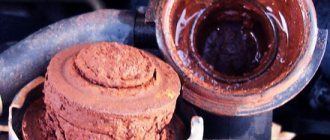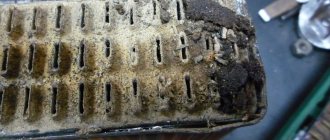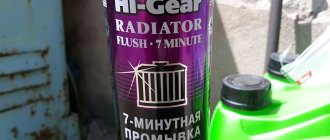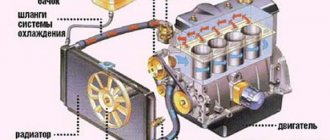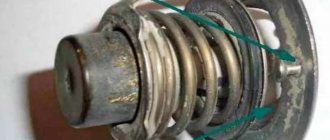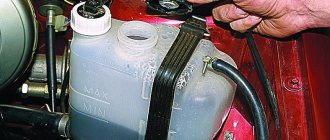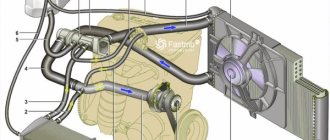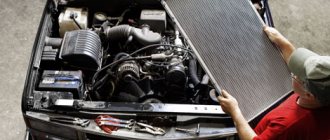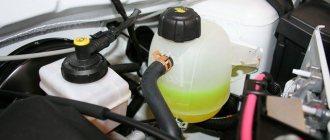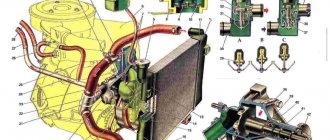Flushing the engine cooling system is one of the simplest procedures that even a beginner can handle.
Moreover, if you figure out how to flush the engine cooling system with citric acid with your own hands, you will save not only on workshop services, but also on expensive reagents. The car cooling system does not require constant monitoring. As long as the machine is working properly, it is enough to flush the system no more than once every two years. But if the readings of the temperature sensor of the cooling system are too high, the engine gets very hot, the fan is noisy, the pump is acting up or the heater is not working well, then it is better not to put off flushing.
How to understand that the stove radiator is clogged
There can be many reasons why the stove does not heat well... Among other things, this is due to its radiator being clogged from the inside with products of coolant decomposition. To check its cleanliness, you need to check the temperature of the inlet and outlet pipes going to the heater radiator on a warm engine. So, if one of them is hot and the other is cold, it means the heater radiator is clogged. A clogged heater radiator will also be indicated by the fact that they are both hot but the heater still blows cold air.
Why do stove radiators clog?
The reason for a clogged heater radiator lies in the coolant. Firstly, in any antifreeze, over time, spent additives precipitate, and secondly, when the liquid is heated, scale gradually appears, and it can also cause corrosion of the surfaces of all elements of the engine cooling system. As a result, all that debris accumulates in the thin honeycomb tubes of the stove radiator. And if antifreeze or antifreeze is of good quality, then these processes occur very slowly, the liquid is of poor quality, then it’s not like a radiator, the engine can be ruined in a couple of years.
When is flushing necessary?
Internal cleaning is recommended at least once a year. It is best to do this after winter is over. A light indicator with a picture of a radiator helps determine the exact time. In addition, there are other signs by which one can judge the need for cleansing.
These include:
Systematic engine overheating and failures when starting it.- Inertia of the rheostat, inhibited response to its signal.
- High temperature readings from the coolant sensor.
- Interruptions in the operation of the pump, signaling problems in the system.
- Change in the color and smell of the refrigerant in the expansion tank.
How to flush a car heater radiator
Flushing the stove radiator video
The stove radiator can be washed either with or without removing it. In the latter case, usually cleaning compounds are simply poured into the radiator or driven by an additional pump connected to the pipes, and then washed with water.
Flushing the heater radiator without removing it
It’s easier to rinse the heater radiator without removing it. To do this, use one of three methods - using two plastic bottles, using a suspended large plastic bottle, or using an external water pump. The described methods allow you to create pressure in the radiator, under which cleaning liquid will circulate inside it.
Washing plastic bottles
Flushing the stove radiator using two plastic bottles
The method of washing with plastic bottles allows you to wash the radiator of the stove in two ways - in a removed state and directly in place from the engine compartment. To operate, you need the following tools: two one and a half liter plastic bottles, radiator cleaner, four clamps. The essence of the method is that the flushing liquid is poured halfway into the radiator and one bottle, alternately driven from one bottle to another by pressing on the bottles with hands or feet. In this way, its internal cavity is cleaned. The method is very simple and effective. When the liquid is very dirty, it needs to be replaced with clean one.
Another method is to cut off the bottom of a large plastic bottle (five to six liters), thus creating a watering can from it. And hang it higher, thus creating pressure for the liquid flowing out of it. Connect one hose to the neck and the first radiator pipe, and the second hose to the other radiator pipe and into a bucket on the floor. To ensure a tight seal, it is advisable to secure the hose to the radiator pipes using clamps.
When flowing out from a height, cleaning fluid under pressure will clean the internal cavity of the radiator. Continue working until the new fluid is sufficiently clean.
Flushing the radiator using a car pump
One of the most effective methods is to make a device based on an external liquid pump, which ensures constant circulation of detergent inside the stove radiator under pressure.
Flushing the heater radiator using a car pump. Photo taken from drive2.ru/users/ya-rusich
To make the device you will need: an electrically driven car pump, three hoses that match the diameter of the radiator and pump leads, a battery charger, an immersion boiler (which needs to heat the liquid), a solution container, a filter element (a synthetic sock or stocking), cleaning composition, a stand for a container with a solution at the pump level.
Connect the pump (inlet/outlet), the radiator (inlet/outlet pipes) and the basin containing the warm cleaning solution with hoses. Place a sock filter on the end of the outlet hose. Start the pump from the battery terminals so that it “drives” the liquid in a circle. And don't forget to connect the charger to the battery as it puts a lot of stress on it.
This will create a looped system through which the cleaner will circulate through the radiator. It is recommended to “drive” the liquid for an hour in one direction and an hour in the other direction. Then replace the fluid with clean one and repeat the procedure again. When finished, rinse the radiator with boiled or distilled water for half an hour in each direction.
All the described methods can also be used if the stove radiator is removed from its seat. This will allow you not only to clean it under pressure, but also simply by pouring special cleaning agents into it. In addition, an additional advantage of dismantling is that the car owner will have the opportunity to remove debris and also inspect it for damage and corrosion.
Ways to solve the problem
In order not to experience discomfort from the cold inside the car in winter, it is necessary to properly maintain the cleanliness of the cooling system. This will require a lot of effort from the car enthusiast. The main problem in servicing this system is that there is no universal means for cleaning the cooling system from both decomposition products of old antifreeze and corrosion products.
Here we can clearly see two sides of the same coin: acid solutions can easily deal with corrosion products, but they are useless for antifreeze residues (alkali is needed here). As you know from a school chemistry course, combining such products in one composition reduces their effectiveness to zero, because alkali neutralizes acid. As a result of this, we get a completely ineffective remedy.
We can draw a simple conclusion: most commercially available specialized chemicals for cleaning a car’s cooling system will not cope with this task fully, so it is necessary to service it in a timely manner so that you do not have to deal with additional difficulties.
How to flush a car heater radiator
On modern cars, heater radiators are made of two main materials - copper and aluminum. For aluminum radiators you need to use acidic agents, and for copper radiators - alkaline compounds. You cannot use alkaline solutions to clean aluminum radiators, as its surface will immediately begin to oxidize, and the clogging situation will only worsen or even ruin the part!
List of products that can be used for washing aluminum and copper stove radiators.
| Means | Radiator type | The need to dismantle the radiator when flushing | |
| Aluminum | Copper | ||
| Lemon acid | ✓ | ✓ | × |
| Table vinegar | ✓ | ✓ | × |
| Lactic acid or whey | ✓ | ✓ | × |
| Battery electrolyte | ✓ | ✓ | ✓ |
| Caustic soda | × | ✓ | ✓ |
| Orthophosphoric acid | ✓ | ✓ | ✓ |
| Boiled or distilled water | ✓ | ✓ | × |
| Special professional products | ✓ | ✓ | × |
Flushing the stove radiator with citric acid
Using citric acid, you can clean radiators made of any metal, both aluminum and copper. There can also be several proportions and recipes for its use. One of them is to take 20...40 grams of dry acid and dissolve them in one liter of water. If the radiator is heavily clogged, the amount can be increased to 80...100 grams per liter (increase the volume of the flushing mixture proportionally). Ideally, the acid solution should be checked using litmus paper - the pH value should be 3 . This is the optimal composition for cleaning the stove radiator.
The acid solution can be used according to the methods described above, pouring it inside. An alternative is to pour it into the car instead of antifreeze, and start the engine for 30...40 minutes, let it idle or take it for a drive, and then leave it overnight. Then drain the liquid; if it is very dirty (with a lot of sediment), the procedure should be repeated one or two more times. After this, rinse the cooling system with ordinary distilled water and add new antifreeze.
Washing with vinegar
Acetic acid is another affordable and effective means for cleaning both the cooling system in general and the stove radiator in particular. To prepare the washing solution, you will need 500 ml of table vinegar, which must be diluted in 10 liters of boiled or distilled water. Otherwise, you can proceed by analogy with washing with citric acid. This composition is suitable for radiators made of both copper and aluminum.
Serum wash
Flushing the stove radiator with serum
The lactic acid present in the serum perfectly washes plaque, rust, and debris from the walls of both aluminum and copper radiators. However, it is quite difficult to find lactic acid in its pure form, so the easiest way is to use natural (this is very important!!!) whey.
To clean the stove radiator you need 5...10 liters. Before use, you need to strain the whey through a filter a couple of times in order to remove any pieces of fat from it!
Most often, it is poured into the system and rolled for about half an hour, and then drained and the system is washed with hot distilled water several times, since the whey contains fat.
Flushing the stove radiator with electrolyte
Battery electrolyte also removes various deposits and deposits well. Almost any electrolyte can be used in sufficient quantities. It can be used to clean both copper and aluminum radiators (but not for very long!). When working with electrolyte, be sure to wear work clothes, rubber gloves, a respirator and safety glasses.
After removing the radiator, fill it with electrolyte and leave it for a couple of hours so that a chemical reaction occurs, during which the dirt and plaque will dissolve. Then drain and wash. Only the first time the water used should be with a small amount of baking soda (1 tablespoon per liter). And then it is advisable to use a cyclic “run” of water through the insides of the radiator.
Washing with caustic soda
Caustic soda is a caustic alkali, it can have several names, caustic soda, sodium hydroxide, caustic. used to clean aluminum radiators, only copper ones and even after removing them from the car , because it has a detrimental effect on the aluminum parts of the cooling system.
And to clean the radiator, use a 10% solution of caustic soda. When making it, personal protective equipment is needed, because if it gets on the skin, caustic can cause a chemical burn. Before use, the resulting solution must be heated, then poured and left for several hours, then drained. If necessary, repeat the procedure two or three times until the liquid being poured out is relatively clean. When finished, be sure to rinse the radiator with clean boiled or distilled water.
How to rinse with phosphoric acid
Phosphoric acid, or rather its 85% solution, sold in specialized stores, is also well suited for cleaning aluminum and copper heater radiators. It is used on radiators removed from cars. You need to work in personal protective equipment, gloves, and a respirator.
You just need to pour the acid inside the radiator and leave it there for a couple of hours. After this, rinse thoroughly with boiled or distilled water. It does not corrode the metal, but instead dissolves the plaque and rust that has formed inside.
Washing with water
The simplest, but most ineffective remedy is ordinary boiled (this is important!!!) or distilled water. However, if you just want to rinse the radiator with water, you need to do this under pressure. As a rule, it is not used in its pure form, but only as a rinse after some kind of product.
Special means for flushing the stove radiator
For those who do not trust traditional “old-fashioned methods,” auto chemical manufacturers have made ready-made products that are specifically designed for cleaning the car’s cooling system.
Popular product LIQUI MOLY Kuhler-Reiniger
- LAVR Radiator Flush Classic . Can be used to flush radiators made of both aluminum and copper. Sold in cans of 430 ml and 980 ml. A small can is designed for a cooling system volume of 8…10 liters. Therefore, its quantity must be calculated in accordance with the volume of the radiator. Instructions are on the package. It is noted that the product perfectly removes rust, limescale, dirt and other debris. The price of one small can as of summer 2022 is about 400 rubles.
- LIQUI MOLY Kuhler-Reiniger . The product is also intended for cleaning the cooling system. Can be used to clean radiators made of any metal. Removes rust, plaque and debris well. sold in a 300 ml metal can, which is designed for a 10 liter cooling system. Costs about 625 rubles.
- Hi-Gear Radiator Flush . A distinctive feature of washing is that it cleans within seven minutes. Can be used to clean any radiators made of aluminum or copper. One 325 ml can holds 17 liters. The price is about 290 rubles.
Please note that old radiators may leak after flushing, since debris accumulated inside could simply seal the housing. Therefore, after washing with special means, it is necessary to rinse the radiator from the inside with water and carefully examine it for leaks at the seams.
How to flush the cooling system when changing the fluid?
If the check reveals that the coolant has an uncharacteristic color, or the engine begins to overheat in hot weather, then it is necessary to drain the old coolant and flush the system with water. You can find the volume of the machine's cooling system in the owner's manual or on the Internet. Usually this is about 7-8 liters for common engines with a volume of 1.5 - 1.6.
Flushing the system with water is simple: fill in the required flush volume, start the engine and wait for the thermostat to open. Let the engine idle for 10 minutes. After this, turn off and let cool. Then the water must be drained and, if possible, the system must be purged with a compressor. If the water is dirty, repeat the procedure.
At the end of the flushing, coolant is added. Every 100 kilometers you need to check its level, the absence of leaks at the joints of the system, and observe the color of the liquid. If it changes again, the system needs more serious flushing.
FAQ
What is the best way to clean a copper stove radiator?
The simplest method for flushing a copper car heater radiator is to use a 10 percent caustic soda solution (caustic soda, mole for flushing plumbing pipes). The hot solution is poured inside for 30 minutes, then drained. If necessary, repeat the procedure two or three times.
Washing with a mixture of citric acid and vinegar also shows good results. However, for an old copper radiator, it would be best to remove, unsolder it and mechanically clean it by hand.
What is the best way to clean an aluminum stove radiator?
To wash aluminum stove radiators, it is recommended to use acid-based products. The best options are whey, citric acid (such mixtures should only be very hot - 90°C) or phosphoric acid solution (heat to 40-50 degrees). And for a copper-brass heat exchanger, only professional products designed for flushing a car’s cooling system will be safe.
How to wash and what proportions for flushing the stove radiator with citric acid?
The proportion for flushing the radiator of a car heater with citric acid is 50 grams of acid per five liters of water. If the radiator is heavily clogged, the amount of acid can be increased to 80 grams. The acid is poured into 0.5 liters of boiled water, stirred until dissolved and then the bulk of distilled water is added.
The liquid is poured into the cooling system instead of antifreeze, the engine is warmed up to operating temperature, and then left to idle for another 15 minutes. Then drain and wash the system 3-4 times with distilled water.
How can I clean the heater radiator without removing it?
Alkaline, acidic or special cleaners are used to flush car interior heater radiators. Alkaline compounds remove scale (lime), and acidic compounds remove rust.
How much does it cost to flush a stove radiator at a service center?
It is necessary to understand that different services, including in different cities, may charge different prices for the service of cleaning the stove radiator without dismantling it. However, as of the summer of 2022, on average, the price of this procedure starts from 1,500 Russian rubles. As for the procedure time, it is about two hours. If the radiator is severely clogged, it may take more time, and the payment will increase, since more cleaning products and worker time will be spent.
Why flush the engine cooling system?
The answer to the question is obvious: to restore its lost characteristics, improve the circulation of coolant, and stabilize the temperature regime of the engine.
Auto mechanics recommend using water first. If the degree of contamination of the cooling system is low, this will help remove all that is unnecessary and extend the life of individual components. But if the car has been in operation for five years or more, and even more so, not from a car dealership, and has changed several owners, then there is a high probability that the cooling system is not as fresh as in previous years.
Some car owners do not repair the system when there are small leaks, but simply add sealant to the coolant. It copes well with small cracks, but at the same time it can clog radiator tubes, damage the thermostat and cause a lot of other troubles if used ineptly.
Problem prevention
After completing the flushing, we recommend carefully monitoring the condition of the engine (in particular, the temperature). If noticeable heating occurs, it is necessary to immediately stop the vehicle, turn off the engine and carry out maintenance on the cooling system. Sudden temperature changes in most cases are due to the fact that the liquid inside the system does not circulate.
In extreme situations, contact a car service center for a comprehensive inspection and diagnosis of cooling system problems. Driving a car with high engine heating rates is extremely dangerous. It can lead to serious problems and the need for major repairs. Good luck on the roads!
Available means
To flush the cooling system, industry today produces a number of chemical reagents. However, we all know that improvised means can often be much more effective. A separate advantage would be to note the cost-effectiveness of such maintenance methods. One of the main ways to prevent incorrect operation of the “stove” is to flush the engine cooling system with citric acid. Let's see why this method is so popular and how to use this affordable troubleshooter?
